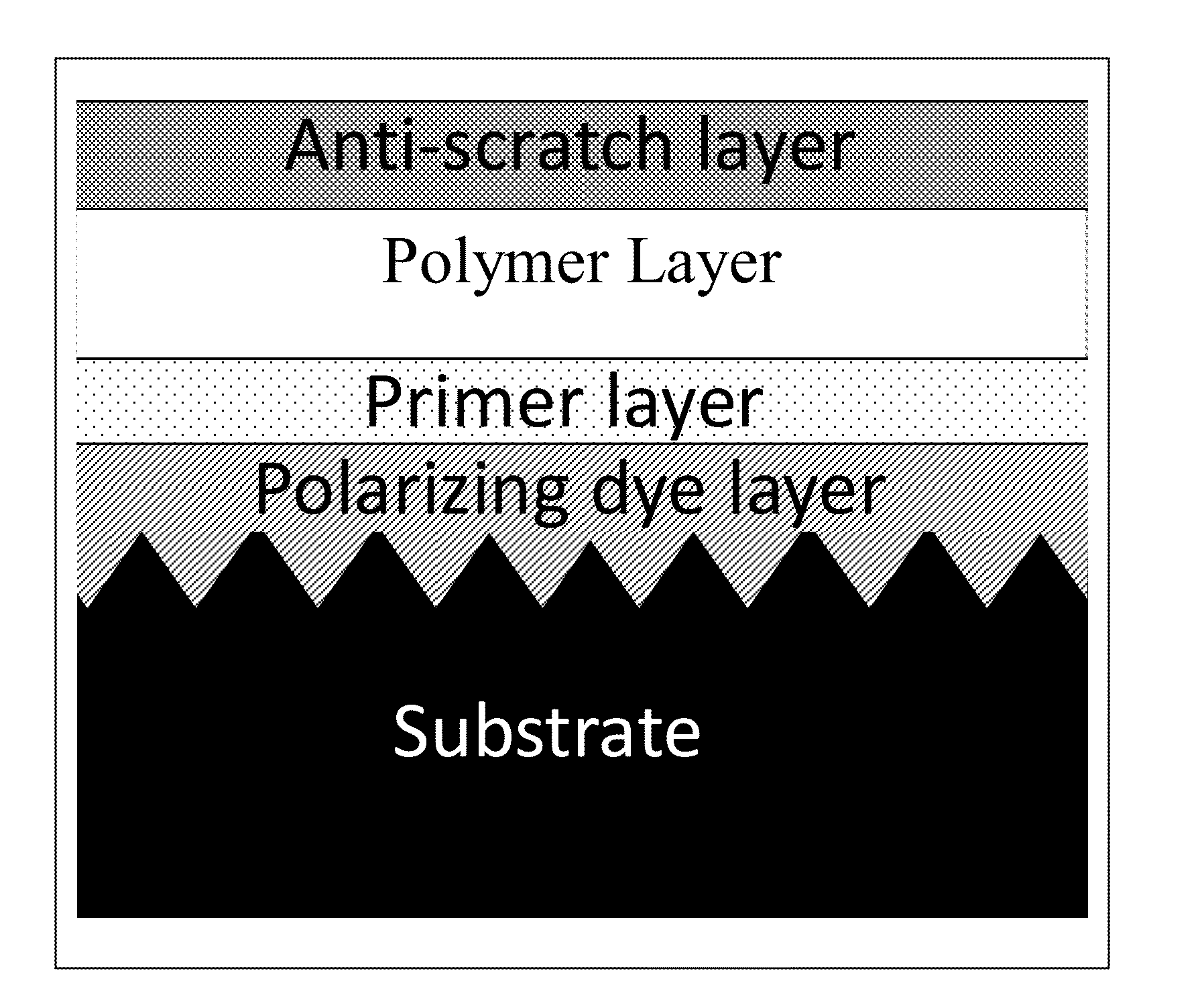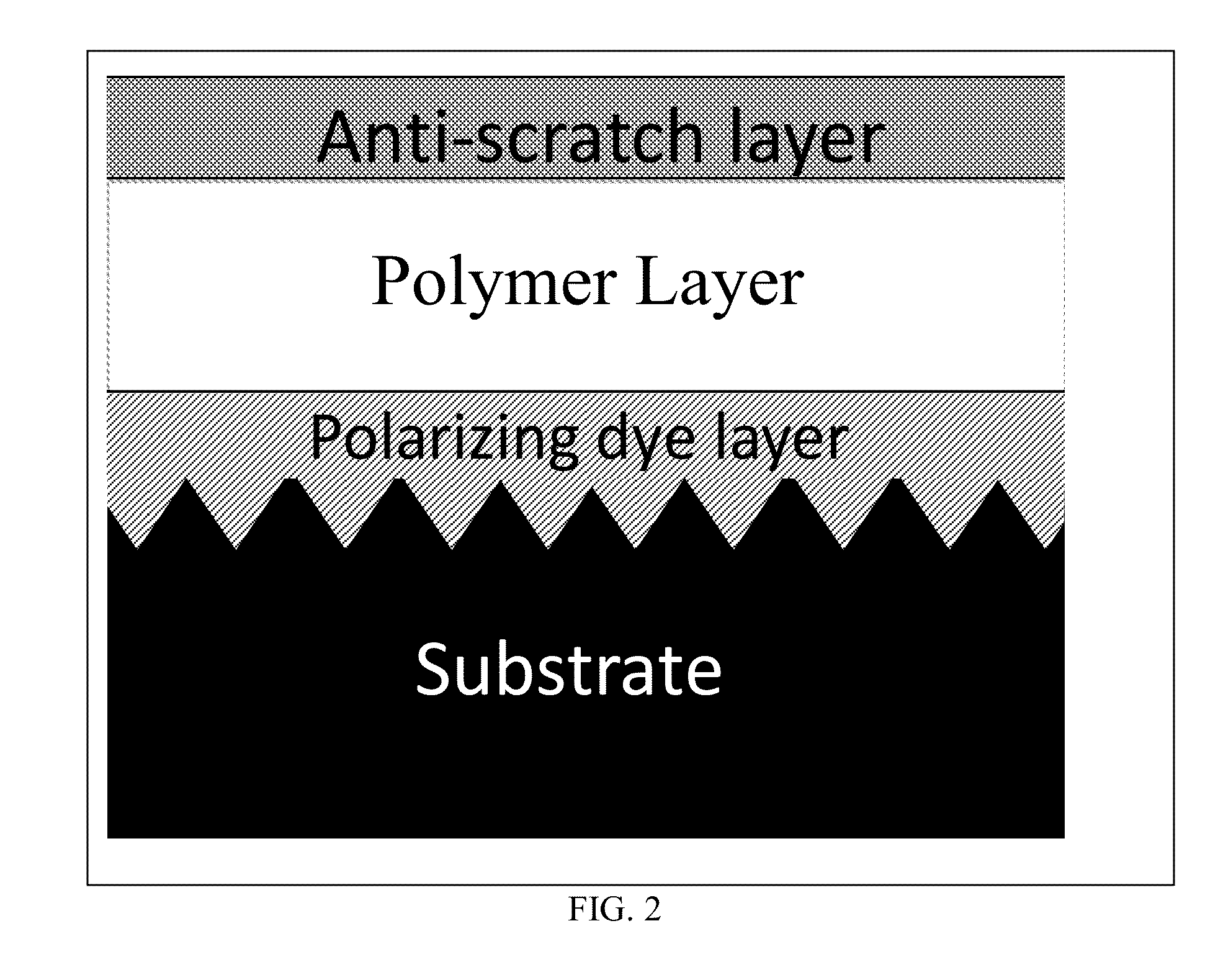Scratch resistant polarizing articles and methods for making and using same
a polarizing article and scratch-resistant technology, applied in the field of light polarizing articles, can solve the problems of scratches or indentations, poor durability of the polarizing dichroic dye layer, cosmetically unacceptable, etc., and achieve the effect of improving the scratch-and-or-indentation resistan
- Summary
- Abstract
- Description
- Claims
- Application Information
AI Technical Summary
Benefits of technology
Problems solved by technology
Method used
Image
Examples
example 1
Part A
Preparation of a UV-Curable Acrylic Coating Composition Enabling the Preparation of the Thick Polymeric First Layer
[0072]A coating liquid obtained by mixing about 90 mass parts of Ebecryl 264 (urethane acrylate oligomer made by Cytec Industries), about 40 mass parts of Ebecryl 294 / 25 (urethane acrylate oligomer made by Cytec Industries Inc.), about 20 mass parts of [3-(methacryloyloxy) propyl]trimethoxysilane (Dow Corning product Z-6030), about 49.2 mass parts of hexanedioldiacrylate, about 6.44 mass parts of Irgacure 184 (Ciba), and about 1.64 mass parts of Irgacure 819 (Ciba).
Part B
Preparation of the Polarizing Glass Lens
[0073]A cleaned chemically tempered glass lens (GS15, Corning) was brushed with a wheel having the appropriate shape and made of polyurethane foam. The wheel was imbibed with abrasive slurry in order to get parallel microgrooves on the surface of the coated lens.
[0074]The abrasive slurry used was an about 12 weight percent (wt %) mixture of water and microme...
example 4
Lens Characterization
[0090]Polarization Efficiency:
[0091]The polarization efficiency (P.eff) was determined by measuring the parallel transmittance (T / / ) and perpendicular transmittance (T⊥) using a visible spectrophotometer and a polarizer. The Polarization efficiency was calculated using the following formula: Peff (%)=[(T / / −T⊥) / (T / / +T⊥)]×100.
[0092]Scratch and Indentation Resistance:
[0093]Scratch and indentation resistance test was performed using a sclerometer hardness tester (Hardness Test Pencil Models 318 / 318 S from Erichsen). Briefly, the test consisted of drawing a hemispherical tungsten carbide tip (having an about 0.75 mm radius) over the surface with a defined constant force.
[0094]A visual mark appearing on the surface after drawing the tungsten carbide tip at about a 5 Newton load indicated a fail of the surface hardness and was rated “X,” whereas lenses showing no scratches were rated “O”.
[0095]In a second step, the pressure on the tip was changed incrementally from abo...
PUM
| Property | Measurement | Unit |
|---|---|---|
| thickness | aaaaa | aaaaa |
| thickness | aaaaa | aaaaa |
| thickness | aaaaa | aaaaa |
Abstract
Description
Claims
Application Information
 Login to View More
Login to View More - R&D
- Intellectual Property
- Life Sciences
- Materials
- Tech Scout
- Unparalleled Data Quality
- Higher Quality Content
- 60% Fewer Hallucinations
Browse by: Latest US Patents, China's latest patents, Technical Efficacy Thesaurus, Application Domain, Technology Topic, Popular Technical Reports.
© 2025 PatSnap. All rights reserved.Legal|Privacy policy|Modern Slavery Act Transparency Statement|Sitemap|About US| Contact US: help@patsnap.com



